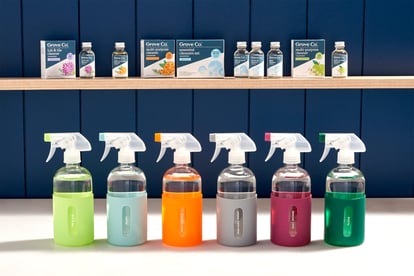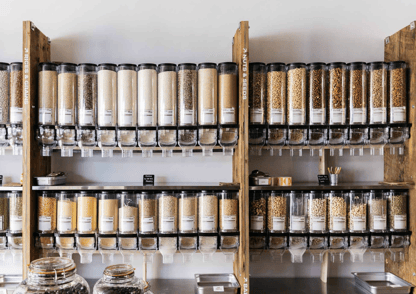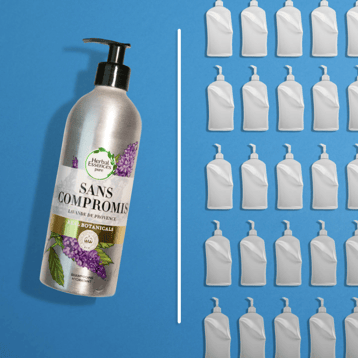Written by
Sam Allen
Historically, the word ‘refill’ has meant getting unlimited soft drinks at your favorite restaurant. Today, we're seeing the term take on a whole new meaning as an effective way to reduce single-use packaging.
As refilling and 'refillables' become more mainstream, how can CPG brands add this method to their sustainability toolkit? What replaces the role of packaging for brand expression if packaging cannot be the primary touchpoint?
Below are a few examples of brands that have caught our attention. As sustainability is embedded in our core values and at the forefront of the work we do with our clients, we've considered these refilling methods and the branding challenges and opportunities that come with them.
Refilling with concentrated formulas
Similar to those classic frozen juice cans your mom would add water to when you were a kid, cleaning products from Grove Collaborative are delivered to the consumer in a concentrated form. The concentrate and water are then added to a refillable dispenser and ready to go. By selling products in a smaller container, everything from packaging materials to gas emissions are reduced.

BRANDING CHALLENGE: Products sold in smaller concentrated formulas in traditional retail environments tend to take up less shelf space, making it harder to stand out next to the larger footprint of non-concentrated competitors.There may also be a perception from consumers that a smaller sized product does not align with an often higher cost.
BRANDING OPPORTUNITY: We see this as an opportunity to elevate brands into a more premium space of desirability. We can do this by building a story around why smaller concentrated formats can be seen as higher value, as well as by developing beautifully crafted, multi-use branded structures that consumers are proud to display at home.
Refilling-centered stores
Maison Jar is a neighborhood refillery in Greenpoint Brooklyn that provides bulk products for customers to fill up on using their own containers. Weigh your empty container first, then fill it up with the products you need ranging from locally-made organic pasta, to herbs, supplements, hand soap, and more. This practice is an excellent way for customers to cut down on excess waste by filling up on only what they need and reusing containers they already own.

BRANDING CHALLENGE: Bulk refill stations at stores like this are typically branded with the store's minimal graphics. This helps build brand equity for the store itself, but not necessarily for the individual products they are selling. Customers leave the store without valuable product usage information or the nutritional facts they normally find on packaging.
BRANDING OPPORTUNITY: Brands can work with refilleries and big box stores to develop branded refill stations that feature graphics or even branded QR codes so consumers can connect with product information and learn more even after they leave the store.
Refillable packaging
Loop partners with global brands like Unilever and P&G to provide refillable packaging for everyday items like deodorant, soap, and even ice cream. Consumers can purchase products at a local grocery store, then return the packaging when they are finished so it can be cleaned and refilled at a Loop facility. Loop's goal is to put an end to the single-use economy.

BRANDING CHALLENGE: Loop’s structures lack some of the 'ownability' and distinction that traditional packaging allows for.
BRANDING OPPORTUNITY: When packaging can’t do the majority of the heavy lifting for a brand, more emphasis can be put on developing the environment the packaging is in, whether that be in-store or e-comm so consumers can engage in the brand world of the product.
We don't foresee 'refillables' slowing down:
As we are confronted with the realities of climate change and our need to evolve consumption habits, we know concepts like refilling shouldn't go away. We say, bring on the branding challenges and let's be ready to adapt!
Interested in hearing more real-time advice on branding and business? Follow us on LinkedIn and subscribe to our newsletter.